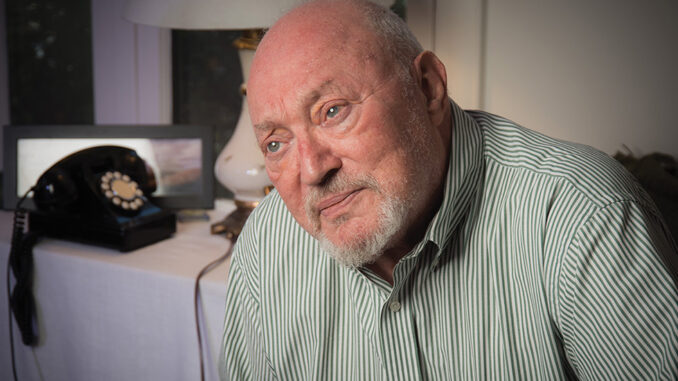
by Michael Goldman • portraits by Wm. Stetz
Editor’s Note: With the recent passing of award-winning editor Jerry Greenberg, ACE, we are re-posting this interview with him from the Q4 2016 issue of CineMontage.
Asked to reflect on his many career achievements and adventures while he’s sitting in his Los Angeles living room on a warm October afternoon, Oscar-winning editor Jerry Greenberg, ACE, briefly hesitates. “I don’t want to give the impression that I’m going toward the end of my professional life knowing that the only thing I’m doing is telling anecdotes,” he explains. “I’ve told many of them before, after all, though the older I get, I realize they are entertaining and an indicator of what my experience may have been.”
This time, however, Greenberg seeks a way to adequately express how much in love he is with the artform of cinematic editing, a relationship that began when he was a young man and escalated to the point where he now calls editing “my mistress, my distraction, the thing I always wanted in my life.” To do that, he patiently explains that he “backed into this business” originally and became attracted to “the rhythm and thought process” that goes into editing.

The affair worked out great for Greenberg. Since the 1960s, he’s amassed over 40 feature film editing credits, including The French Connection (1971), for which he won an Academy Award; Apocalypse Now (1979), for which he was co-nominated for an Oscar, along with Walter Murch, ACE, CAS, MPSE, Lisa Fruchtman and Richard Marks, ACE; Kramer vs. Kramer (1979), Scarface (1983) and many others. In 2015, the American Cinema Editors (ACE) presented him with its Career Achievement Award. This fall, his work on The French Connection returned to prominence as that film celebrated its 45th anniversary.
Proud as he is of his body of work, however, Greenberg is more gratified by the fact that he once served as apprentice, assistant and, more importantly, dear friend to award-winning editing legend Dede Allen, ACE (Bonnie & Clyde, Serpico, Dog Day Afternoon, The Breakfast Club, among many others). So, in talking to him, if it is fond memories you want, Allen is an excellent place to start.
“All my experiences with Dede were…I don’t have one word for it,” Greenberg says softly. “I became an acolyte. She was such a pillar of the editing world, of course. But to me, she was always much more than just that. What was it like for me? Life-saving. I’m not a sentimentalist — I don’t go for all that. But my time [as her apprentice and then assistant] was about going from not knowing what I wanted to do in a moment’s time to knowing that what I’m doing now is the only thing I want to be doing. How do you describe that?”
He gets a bit emotional when talking about Allen, who passed away in 2010. So he slows down and then explains how he found his way into her editing room as an apprentice on Elia Kazan’s America America back in 1963.
The Beginning
Greenberg grew up in a middle-class Jewish home in New York with no connection to, or interest in, the entertainment industry beyond the fact that “movies were part of your fantasy world and your social life. They were part of every kid’s life,” he says. “We went to matinees all the time. But I certainly wasn’t bitten by the show business bug.”
A school chum, however, eventually landed in the New York industrial film scene as a production manager for a start-up company. He helped Greenberg secure what he calls “the lowest job” there, doing a little bit of everything before eventually learning the basics of sound editing. Ironically, he insists, it was while doing simple sound editing tasks that he began to groove to the importance of picture editing in a sort of roundabout way.
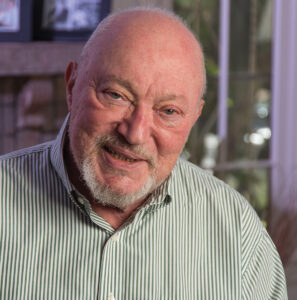
Portrait by Wm. Stetz
“I did small jobs, like choosing music,” he recalls. “Editors would send a work print with all the splices in it. It was the only visual copy of what they had, because a lot of them didn’t have the money to duplicate it so that we didn’t have to run all those splices through the Moviola. But it was often the case that the splices would go through, and you could hear them. They had a rhythm — a clackety-clack that I would hear while I was choosing new music. Eventually, I began to see that all the decisions to go from one shot to another had to be thought out as to [how they would match] visually. Most of the time, I didn’t have an audio track. It all was done silently, because all I had to do was choose underscoring, which was usually played very lightly underneath either dialogue or sound effects.
“I realized there was a thought process that went into all those cuts,” he continues. “That seemed magnetic to me. I was drawn to that, and began to realize that was something I could do. I was already fairly accomplished [with sound editing], but it was rudimentary and simple at the time. I wanted to put more thought into it, like playing with blocks again — picking them up, stacking them, putting them in certain relationships, then taking them apart and putting them back together again in different ways. I know that sounds philosophical, but that was the thing that ignited me. I began to see that sound editing, as it existed then, was much less inviting than the thing that preceded it — the visual item.”
Eventually, Greenberg objected to the mundane chore of applying sound effects to Shell’s Wonderful World of Golf, so his bosses hired someone else for that task: Eddie Beyer, who went on to become an accomplished sound editor. Greenberg says that Beyer “knew the New York feature film world” and had learned that Allen’s assistant was leaving as she was starting on America America (1963). So he recommended Greenberg to the production. Allen eventually agreed to take him on as an apprentice editor.
“The way we worked was, I was right next to Dede. I was her handmaiden — as assistants were in those days — where she would hand you something, and you had to do something with it,” Greenberg recalls. “She was talking mostly off the top of her head, and you had to be on your toes and not disregard what she was saying, because sometimes the question would come to you. So you had to be alert.
“But you were also an observer, watching her dance around this crude editing machine,” he adds. “Doing all those things — talking, looking in the machine, putting film together — it had this choreography. I was always aware of that. I was aware that at the heart of it was thinking. You had to think and also edit yourself. You could do and then undo things, and the most important part of doing [was not knowing what you might have to undo]. It was the after-editing — or self-editing, if you will — and Dede was a master of that. That was the first thing I adopted from her as a tenet. That was instructional for me, and it was part and parcel of watching her physically operate. There was a closeness that doesn’t exist now [between editors and assistants]. I was very fortunate to experience that.”
Taking the Lead Chair
After rising to serve as her assistant on many notable projects, Greenberg says Allen eventually recommended him for his first editing job — on Sidney Lumet’s comedy Bye Bye Braverman in 1968. He says Lumet interviewed him for the job on, of all things, a New York City bus, which he was using to shoot a scene for the film. The interview was short and sweet, according to Greenberg. “I stepped off the bus, and I don’t think I felt the ground,” he recalls. “I was over the moon.”
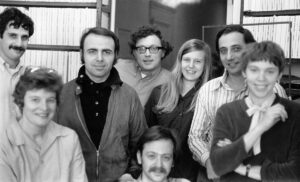
Lumet tightly took charge of the editing process on that project, but Greenberg calls it “a start” and his opportunity “to meet a lot of the glitterati of New York filmmaking.” It launched his life as a professional film editor, though he was not yet, in his words, “anyone’s first choice.” It was, he says, William Friedkin who helped him head toward that designation when the director hired him to edit a controversial comedy based on a play about gay life in the 1960s, The Boys in the Band (1970).
This was another comedy, but what Greenberg calls “an integrated comedy.” By that, he means that the script by Mart Crowley, author of the original play, “said an awful lot about the difficulty of living as a gay person in those days. I understood this material was not all just the camp kitsch it could have been in the hands of some other director. [The humor] was meant to interrupt the seriousness of people in pain, and I enjoyed that challenge. I thought I could play a part.”
Greenberg says The Boys in the Band was therefore the project on which he got his first real opportunity as a film editor to “make decisions about what shot to use or do, or how scenes should be presented” in a much freer manner than he was able to do in Lumet’s orbit. The modest success of that film, and Friedkin’s approval of his work, led the director to continue their partnership on his next project, 1971’s The French Connection, which won Oscars for Greenberg, Friedkin, screenwriter Ernest Tidyman and actor Gene Hackman, as well as Best Picture.
The Big Chase
The current anniversary of that classic film brings back fond memories of its classic car chase, which Greenberg edited. The chase, he says, was inspired in his mind by another famous car chase, in Peter Yates’ Bullit (1968). He is proud of the accomplishment, but at the time, he says, “We didn’t talk about the car chase that much, because when you write a script and put in an action scene, the scene might be 15 minutes — but it is described in a third of a page of the script. So you don’t really know what you are going to get.”
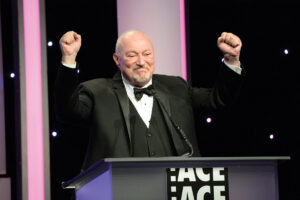
PeterZakhary/Tilt Photo
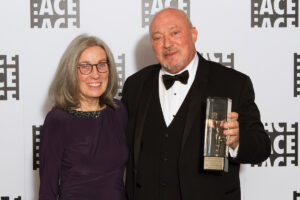
Linda Treydte/Tilt Photo
What has been widely discussed are the elements he eventually got, thanks to Friedkin’s on-the-edge, and sometimes dangerous, shooting style for that section of the movie during a famous shoot on the streets of Brooklyn. Less discussed is how Greenberg and Friedkin then made sense of all that material to ratchet cinematic tension up to the max in a way that served the story.
“I always liked the fact that every time you put two pieces of film together, you have created more work for yourself than you could have imagined before you put those two pieces of film together,” he says. “That was never daunting to me; I wanted that. Knowing how long the scene was going to be in terms of footage and raw material, I knew it would take all my imagination, that I would have to think about it 24 hours a day. But I loved that.”
The editor continues his recollection: “We had the chase on the ground, the chase in the subway itself, and the relationship between the two — the car chase and the murder that was about to happen, and with the danger that was about to happen later on with the train hurtling out of control. All those things were somehow going to have to blend. All the fantastic chases are the same in the sense that they are multi-part — mini-movies in themselves. The editing became like those Russian [Matryoshka nesting] dolls that go from small to big. We were editing four mini-films together.”
On Collaboration
Greenberg says his success on his two films with Friedkin was in part a result of the fact that his collaborator was a director “of considerable ability when it came to taking a point of view on how a film is to be presented.” He puts the director with whom he has had his longest and closest association into that same category: Brian De Palma. The pair teamed on five films in the 1980s, including Dressed to Kill (1980) and Scarface (1983).
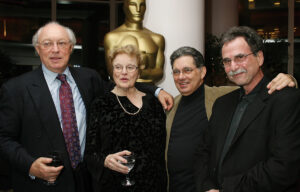
The editor was initially attracted to working with De Palma when the director interviewed him for Dressed to Kill at the behest of De Palma’s longtime editor, Paul Hirsch, ACE, a friend of Greenberg’s, when Hirsch’s schedule precluded him from taking the gig. The reason he wanted to do the film, Greenberg says, was the fact that De Palma had crudely storyboarded the entire movie himself, including minute details.
“He had me down to his office, which was a residential apartment in Manhattan,” Greenberg recalls. “He took me into a small dining room that was, because of the size, completely mirrored to make it appear larger, I guess. On the dining room wall, all around, he had taped three-by-five-inch file cards, storyboarding the whole film. All the drawings were his — simple stick figures most of the time, where he would try to indicate camera movement with little arrows and stuff like that.
“That might seem threatening to another editor,” he continues. “But to me, I thought, ‘Here was a director who knew how his film should be edited.’ I liked that the director knew a little bit about editing, and I felt encouraged. I loved editing that movie. It wasn’t necessarily just the performances or the hooks, the usual things that get you into it. I was doing it completely for the camera work — the way he used the camera, and that was very exciting.”
Still, Greenberg insists the fact that he worked with De Palma five times — more than he worked with any other single director — “was just a coincidence.” Indeed, he emphasizes that he is an editor who never pursued a single collaborative partner on which to hang his hat.

“I don’t think of myself that way in a working sense,” he offers. “I don’t think I generate a lot of confidence in directors in that way. Consequently, although maybe Brian De Palma is an exception, I don’t think I inspire that kind of ‘I’ll just continue working with him’ thing with directors. But then, I never wanted to do that anyway.”
Indeed, Greenberg says he doesn’t view “collaboration” as being just about his relationship with the director. Nor does he express common concerns among editors about being asked to re-cut his work, or even having others re-cut his work. He’s experienced it all over the years — from having wide latitude to having almost no latitude at all. And it’s all fine with him, he says, because, in his view, the nature of a collaborative art like filmmaking involves a work being in a sense passed around and “embellished” by different people repeatedly, a process he says he loves.
“Usually, the task goes from one to the other, so that at every step in passing it, it is embellished and then witnessed by other people, whatever the embellishment was,” he explains. “That is the kind of collaboration filmmaking is. It isn’t a sure thing, but it is a wonderful thing. Being able to pass a responsibility, and different ways of seeing things, from one person to the other, even if it goes on and on — I think that’s terrific. Because, if you have an open mind, what you can do is change what you had done originally, and make it something you could never have thought of on your own. That’s why I’m never threatened by anybody who wants to re-edit my work. I feel like maybe their ideas will spark more ideas in me.”
What’s Next?
All of which begs the question, what’s next for Jerry Greenberg? He insists he’s still available, having most recently co-edited the remake of Point Break in 2015. He’s come to love nonlinear digital editing after making the transition long ago, because digital editing “allows me to see what I’m thinking” during the cutting process.
But at the same time, he’s in no rush to jump into anything one way or another at the age of 80. He feels we live in a society where “everyone wants quick, because time is money and all of that, and sometimes that leads to them saying, ‘That’s good enough,’ as in whatever you come up with [the first time] is good enough. Well, I don’t do quick.”
Therefore, when asked what exactly his current plans are, Greenberg, in typical, wry fashion, answers as truthfully as he can. “I’ll be having lunch,” he promises with a gentle smile.






